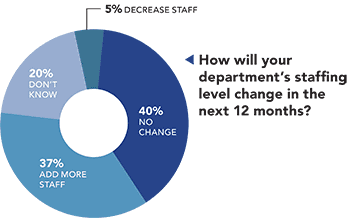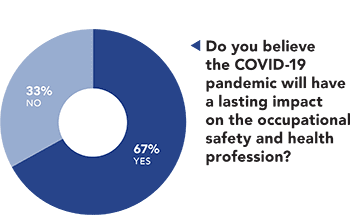2022 Job Outlook

Jennifer Strackbein’s family and friends have a better grasp of what she does for a living. That’s one of the changes she’s experienced in the two-plus years since the onset of the COVID-19 pandemic.
“They didn’t understand what public health or worker health meant or why it was important,” the senior principal environmental, health and safety regulatory compliance analyst at Northrop Grumman said. “Now they see why my role in a workplace is critical.”
The Safety+Health 2022 Job Outlook asked occupational safety and health professionals about other changes they’ve observed or experienced since the pandemic began. The majority of respondents agreed with the following statements:
- The pandemic has increased the general public’s awareness of the OSH profession.
- The pandemic has increased the profile of the OSH function within my organization.
- Workers are more aware of their personal safety and health.
- Worker well-being is now a stronger area of focus in the OSH field.
“Even though we work on fall protection, chemical safety and other hazards that can be very damaging or even fatal if poorly handled, few people know workers who were killed on the job,” Strackbein said. “Unfortunately, many people know someone who was killed by COVID-19, so it may be easier to see now why prevention is so important. I believe the pandemic provided an especially tangible way to see how a good safety program saves lives.”
|
What's the Job Outlook for safety professionals? Browse the 2022 survey results | |
 Safety staffing |
 Impact of COVID-19 |
| Personal job outlook | About the profession | Profile of respondents | Comments on COVID-19 |
Being prepared
Preparation was a common theme in comments to the survey’s open-ended questions, including: What lessons have been learned?
One respondent wrote, “We have to prepare and have disaster plans and contingency plans. We have to plan for things to be different in the future, and nothing should be considered normal.”
Another question asked: Do you believe the COVID-19 pandemic will have a lasting impact on the OSH profession? (Sixty-seven percent of the respondents said “Yes.”)
One respondent added: “I think the pandemic will heighten safety professionals’ response to future epidemics and pandemics. Knowing a road once traveled allows one to refine responses and actions for future disruptions.”
Another wrote: “It provided a real example for preparing and planning for unexpected events. As a manufacturer, we had never considered protocols and contingency plans for a pandemic. Now that the blue-print had to be created in response to COVID-19, non-health care entities have plans that would address another pandemic such that companies are more prepared to not be caught off guard by such an event.”
Staying put
Nearly two-thirds (63%) of the survey respondents said the pandemic hasn’t changed their perspective on the workplace safety and health profession.
“We are now recognized for being able to cover a bigger scope, but my feelings have not changed,” one respondent wrote.
The public health crisis has provided a “golden opportunity” to research programs on bloodborne pathogens, infectious diseases, respiratory protection and personal protective equipment assessments, said another respondent, “to ensure they are still relevant and applicable to the pandemic.”
That respondent added: “Plus, many safety professionals had an opportunity to be a resource to human resources departments in regard to cleaning chemicals, cleaning schedules, PPE use, social distancing, etc.”
Even amid the “Great Resignation,” an economic trend that began last year in which employees are voluntarily resigning from their jobs en masse, 76% of the respondents indicated they don’t plan to leave their current employer in the next 12 months and 59% don’t see themselves leaving in the next five years.
As for the future, Strackbein said safety pros and their teams have an opportunity to use their “seats at the table” earned over the past two-plus years to “emphasize that safety does not stop when COVID-19 is declared to no longer be a pandemic.”
| NEXT Survey results: The safety function in your organization |
> |
Post a comment to this article
Safety+Health welcomes comments that promote respectful dialogue. Please stay on topic. Comments that contain personal attacks, profanity or abusive language – or those aggressively promoting products or services – will be removed. We reserve the right to determine which comments violate our comment policy. (Anonymous comments are welcome; merely skip the “name” field in the comment box. An email address is required but will not be included with your comment.)

